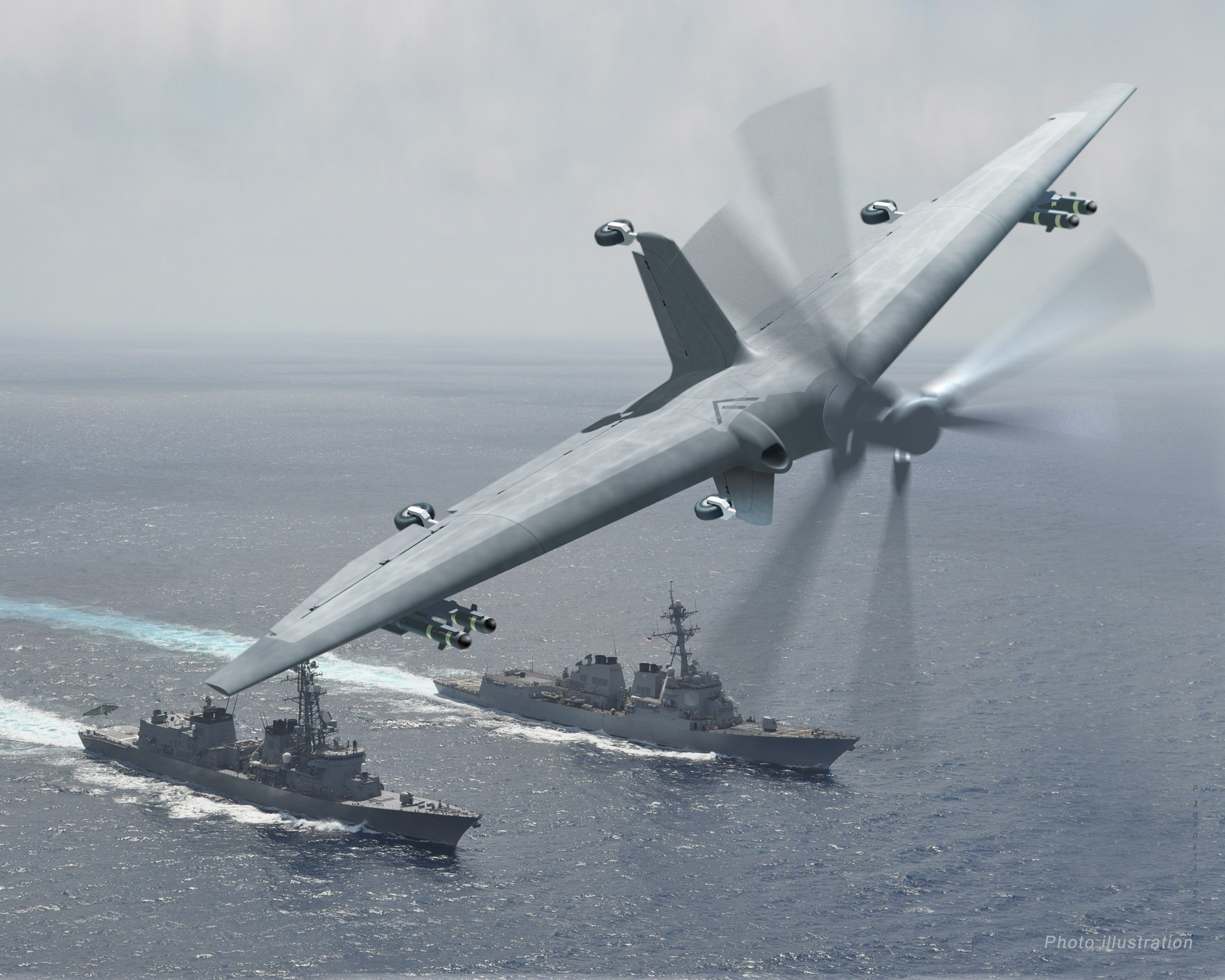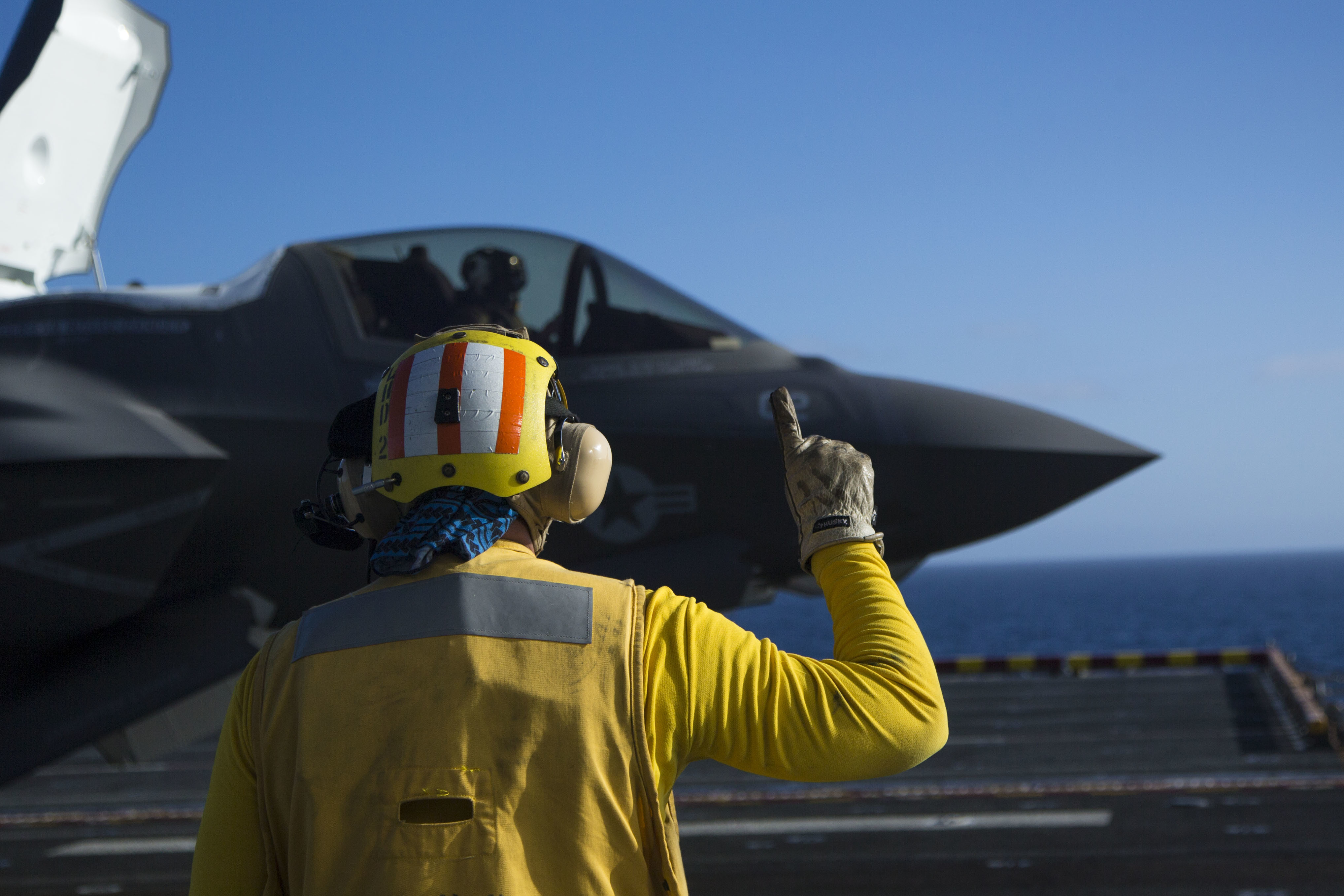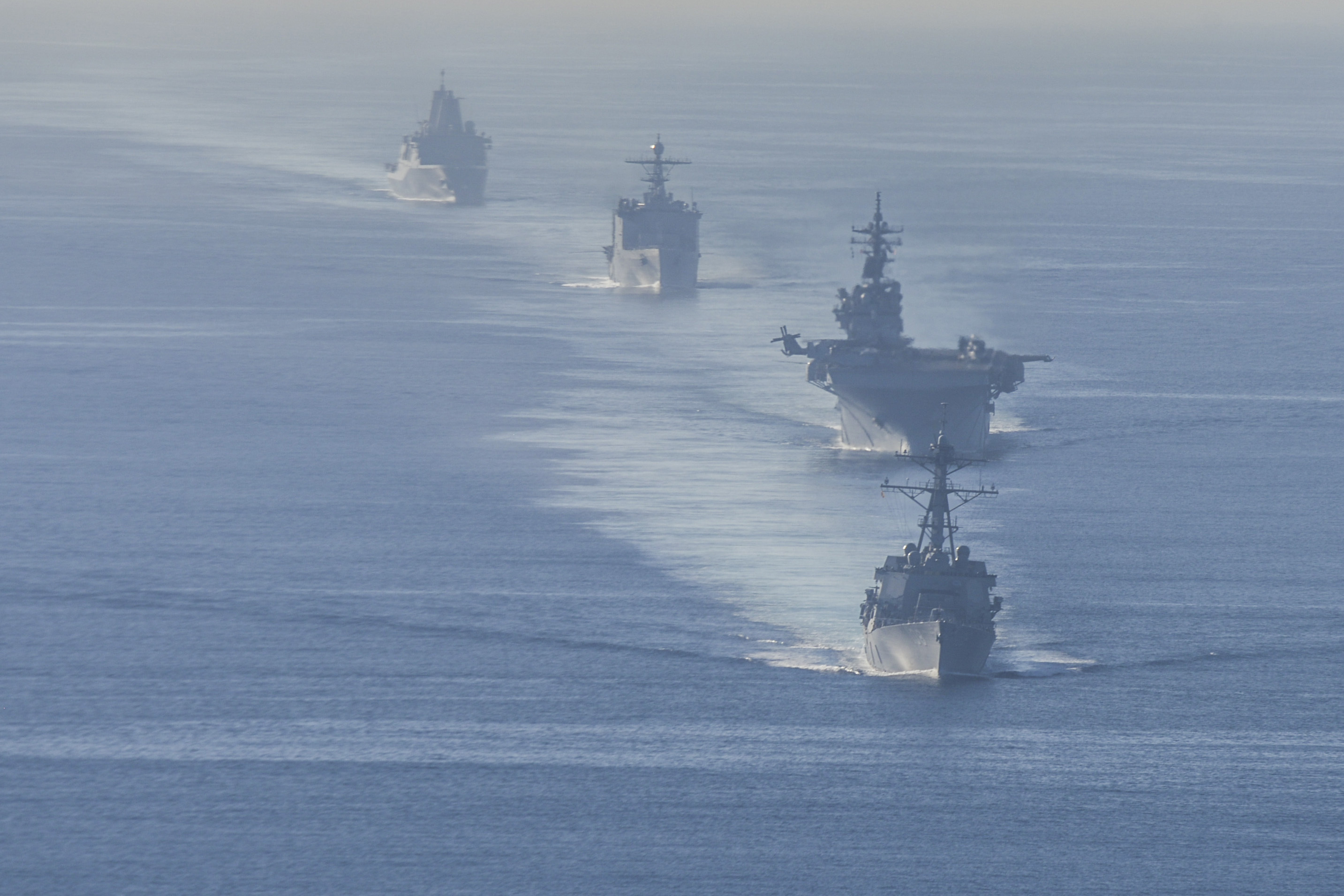
FREDERICKSBURG, Va. – The Marine Corps and Navy are preparing for a high-end fight that will require ships to be distributed across the ocean rather than clustered around an aircraft carrier, and the Marines’ future Group 5 unmanned aerial system will give them the airborne early warning capability to break free from the carrier and its E-2D Advanced Hawkeye early warning aircraft.
With the F-35B Lighting II Joint Strike Fighter now fielded, an Upgunned Expeditionary Strike Group (ESG) – a typical Marine Expeditionary Unit (MEU) embarked on a three-ship Amphibious Ready Group (ARG), plus a couple cruisers or destroyers – is a formidable naval unit: it carries a Marine landing force, a fifth-generation stealthy fighter capability, a high-end radar paired with the Aegis Combat System, and the networking to tie them all together. The only thing missing is an airborne early warning system like the Navy’s E-2D to identify and cue surface and air threats.
That is the capability gap the Marine Air-Ground Task Force (MAGTF) Unmanned Aerial System (UAS) Expeditionary – or MUX – will fill.
“Think about the ESG, the Amphibious Ready Group, the large-deck amphib: even if it’s upgunned with a set of [surface warfare] assets with Aegis radars, we are still missing an airborne early warning capability. And therefore, in the fight of the future, we are going to be tied to the carrier strike group,” Brig. Gen. James Adams, director of the capabilities development directorate at Marine Corps headquarters, said during a MUX industry day presentation today.
“That’s why airborne early warning is our number-one top-tier requirement (for MUX). We don’t have an E-2D obviously with the ARG, we could never get one, but we need that capability present inside the ARG as we distribute forces in connection with and in support of the concepts – [Distributed Maritime Operations], [Littoral Operations in a Contested Environment], [Expeditionary Advance Base Operations] – in the future and enable the naval force to be more lethal and allow us separation from and integration with the carrier strike group. And that’s why [airborne early warning] is so important and why it bumped up from being way down somewhere in the ICD (initial capabilities document) as a nice-to-have to an absolute essential must-have.”
Adams said some lawmakers have gone so far as to suggest a light-carrier concept for the Marines so they could operate their own E-2Ds and have airborne early warning capabilities in ARG/MEU operations, and he said fielding the MUX will be a better solution to bringing that capability to the amphibious force.
When the MUX ICD was approved in October 2016, the Marines had laid out seven missions for the vehicle. Based on early industry feedback and evolving operational needs, airborne early warning is now the top priority. Intelligence, surveillance and reconnaissance (ISR); electronic warfare; and communications relay are also considered Tier 1 missions, with offensive air support being a Tier 2 mission. Escort and cargo have been struck as missions, with those requirements likely being filled by the Future Vertical Lift program in the 2030s.
Adams spoke of MUX as a key integrator of Marine forces fighting at sea or moving ashore, of naval aviation assets in the air and other ships in the fleet operating at sea.

He said dropping offensive air support to a tier 2 capability – which means the final MUX system the Marines build may not carry any offensive weapons at all, if the winning design chooses not to include them – is a fine tradeoff because “if the MUX system is able to cue a designated target in accordance with the Tier 1 capabilities, there are a plethora of weapons available in the CEC (Cooperative Engagement Capability network), in the NIFC-CA (Naval Integrated Fire Control-Counter Air) scenario, that it can fire,” Adams said.
“So in some respects, it has an unlimited magazine because it’s the cue-er of other people’s weapons, whether it’s an SM-6 (Standard Missile) coming off a ship, or a [Small Diameter Bomb] coming off an F-35 – it can provide [offensive air support] cueing in the networked fight of the future.”
Adams noted that hanging weapons on the MUX could also reduce airspeed, endurance and payload capacity – a trade the Marines aren’t interested in.
The MUX will have about eight hours on station at 350 nautical miles from the ship, Adams said. A speed requirement isn’t set yet – Adams said it would likely be around 200 knots, though the Marines might accept something closer to 175 knots if it led to greater capability elsewhere.
The Marines also haven’t set a cost cap yet. Deputy Commandant of the Marine Corps for Combat Development and Integration Lt. Gen. Robert Walsh said at the event that MUX would be comparable in size to the Group 5 Reaper, at $16 million apiece, and Predator, at $22 million apiece. The shipboard compatibility and runway-independence will likely add some cost, he said, but the Pentagon is unlikely to approve the program if it costs much more.
“It’s got to be somewhere in that area, it’s got to be not a whole lot more. So we’re talking in the 20s, mid- to high-20s,” he said.

Deputy Commandant for Aviation Lt. Gen. Steven Rudder said at the event that several programs are winding down acquisition in the coming years, such as the H-1 helicopter, the MV-22 Osprey and the KC-130J cargo plane. Though others like the F-35B and the CH-53K heavy-lift helicopter are moving into the multiyear procurement phase, there is room in the budget for the MUX and “we’re prepared to go fast, assuming that there’s technology there that allows us to go fast.”
He said the 2022 or 2023 timeframe is where the former set of aircraft transition from procurement to sustainment and where the latter set of aircraft move into multiyear procurement, and so he’s eyeing that same timeframe for the beginning of MUX procurement if the technology develops fast enough.
“We believe the technology exists to do it, we believe now is the right time to begin this journey of this program to be able to give the United States Marine Corps, the Navy, the Army, the Joint Force a capability that is expeditionary, doesn’t require a runway, and is a value to the naval force,” Rudder said.
Navy Capt. Jeffrey Dodge, the MQ-8 Fire Scout UAS program manager who is coordinating Naval Air Systems Command’s involvement in MUX, said at the industry day that an analysis of alternatives (AoA) would take place later this year. The Marines would ideally pick a couple vehicles that could begin prototype testing quickly, allowing the service to select one in Fiscal Year 2020 and begin the formal program of record at the Milestone C production decision, rather than taking on a major government-led development effort.
After the 2020 downselect would come air vehicle development, integration of early payloads, the completion of land-based testing, and then some sort of operational evaluation so the Marines could declare early operational capability for land-based use. The shipboard testing and certification would take longer, Dodge said, but the Marines could use the MUX in its expeditionary role while the shipboard portion of engineering and testing continued.
Ultimately, the Marines are designing this program with future sales to the Army, Navy, U.S. Special Operations Command and foreign militaries in mind, with the goal of decreasing program cost by increasing total quantity. To support that, Walsh said it would be important for the payloads to be separate from the airframe, so that SOCOM could potentially invest in a higher-end payload, or a foreign navy could buy a scaled-down payload.
Ultimately, though, Walsh said ensuring shipboard operability – including fitting in a destroyer’s hangar and taking up about the footprint of a UH-1 helicopter – remains a top priority for the Marine Corps.
“Two years ago when I walked the ICD to the [Joint Requirements Oversight Council … [the first reaction] was, we’ve got a lot of Group 5’s, they’re all over the world doing things. Why is yours different?” Walsh said.
“It was the shipboard compatibility, the expeditionary capability that allowed that ICD to go through. That was the only thing.”





